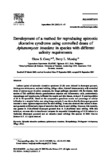Development of a method for reproducing epizootic ulcerative syndrome using controlled doses of Aphanomyces invadans in species with different salinity requirements

View/Open
Date
2002Page views
378Metadata
Show full item recordCited times in Scopus
32 readers on Mendeley
Share
Abstract
Lesions typical of epizootic ulcerative syndrome (EUS) were induced in three-spot gourami, Trichogaster trichopterus, and sand whiting, Sillago ciliata, injected intramuscularly with controlled doses of Aphanomyces invadans zoospores, the fungal pathogen associated with the disease. Both species of fish exhibited chronic granulomatous response and inflammatory cells, predominantly macrophages and lymphocytes, infiltrated the muscle and skin tissues, at days 6–8 post-inoculation of 65 to 85 spores/fish. Based on the comparative granuloma counts and percentage of cellular infiltration in a sampled lesion area using image analysis, it was shown that the three-spot gouramis mounted a more vigorous response than the sand whiting. It was also observed that lesions in three-spot gouramis exhibited early signs of resolution than those in sand whiting. However, fish mortality was greater in EUS-affected three-spot gourami than in EUS-affected sand whiting. With this technique, we were able to describe and compare the sequential histopathology of EUS lesions in a freshwater (three-spot gourami) and an estuarine (sand whiting) fish species.
Suggested Citation
Catap, E. S., & Munday, B. L. (2002). Development of a method for reproducing epizootic ulcerative syndrome using controlled doses of Aphanomyces invadans in species with different salinity requirements. Aquaculture , 209(1-4), 35-47. https://doi.org/10.1016/S0044-8486(01)00805-5
Subject
Taxonomic term
Collections
- AQD Journal Articles [1248]
